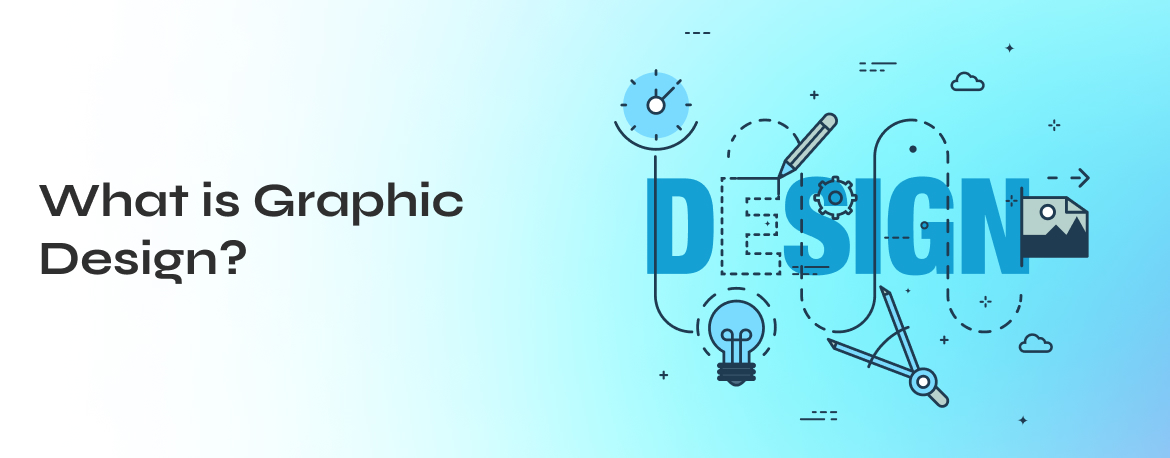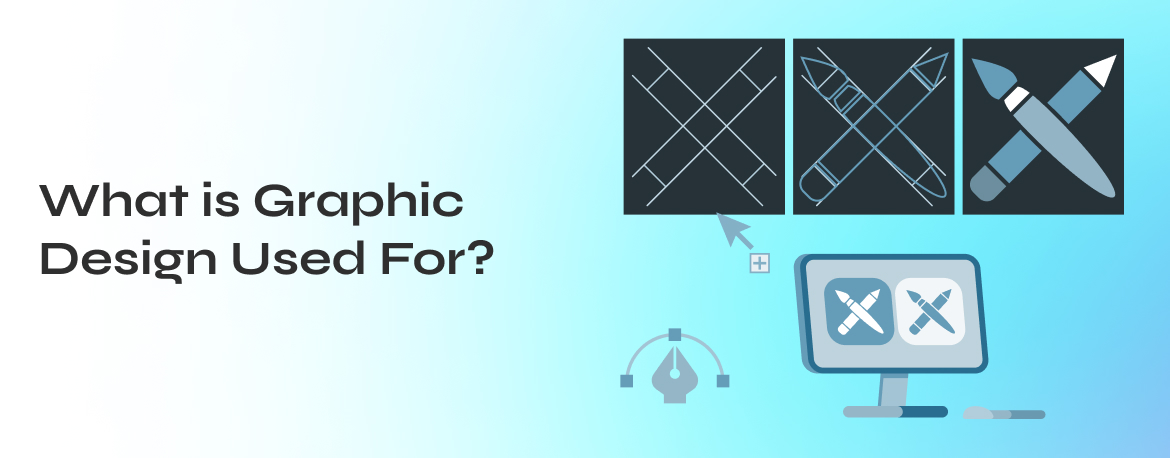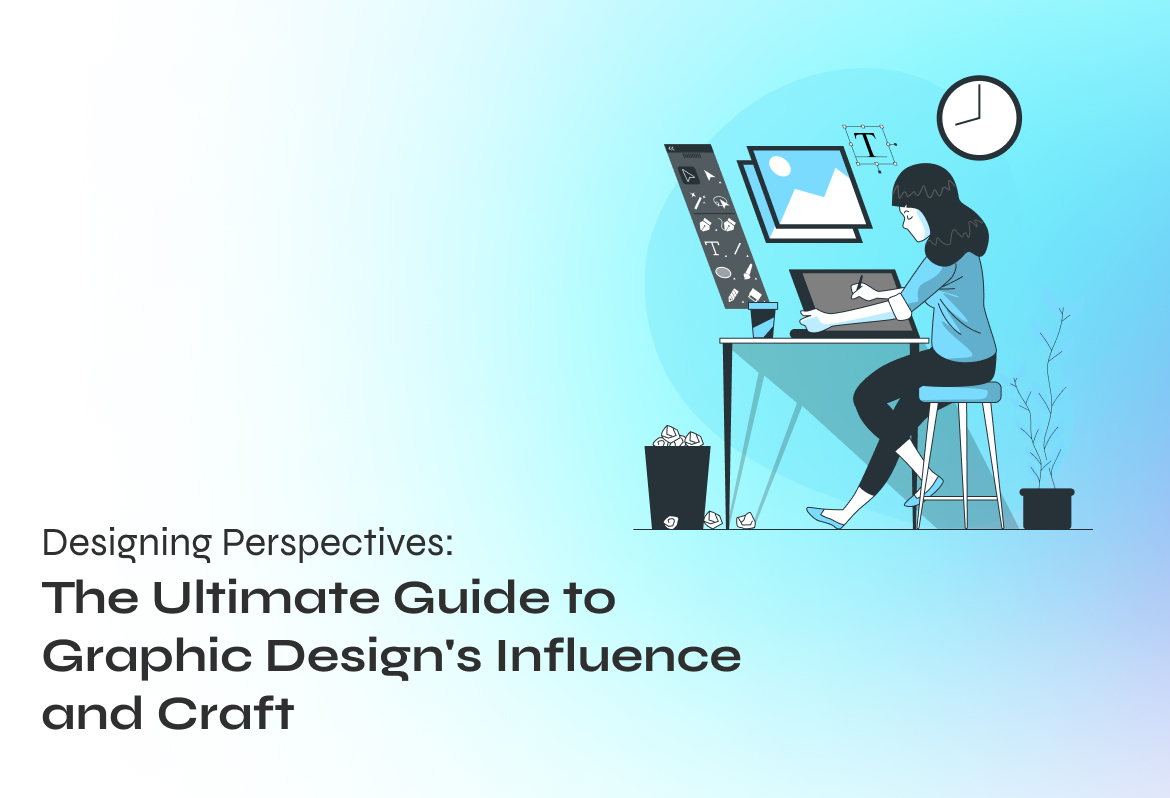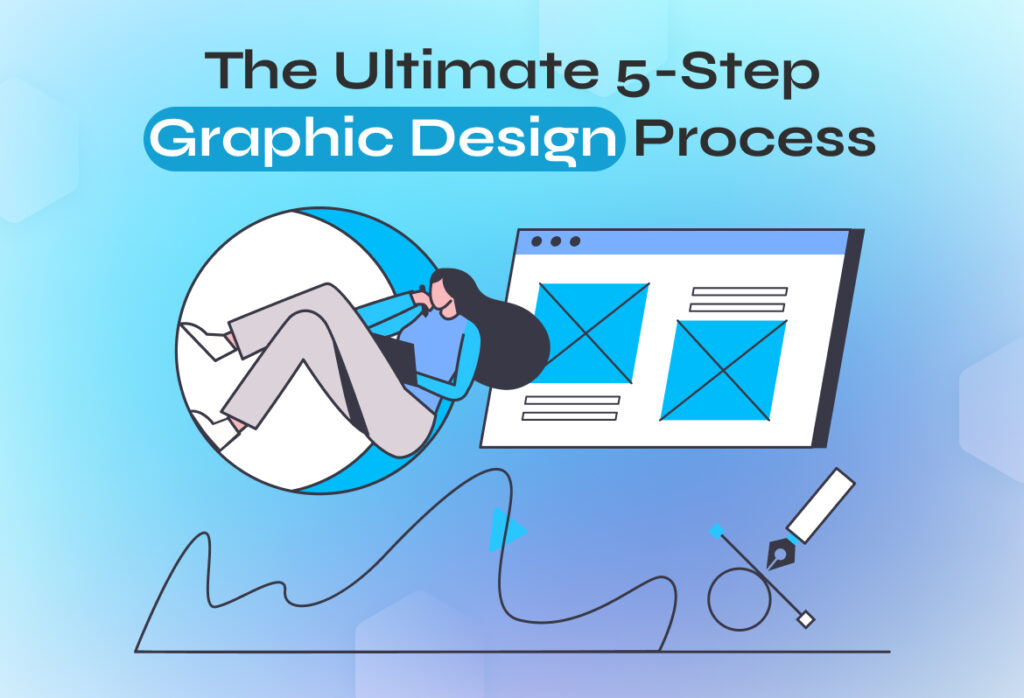Graphic design, often seen as the art of visual communication, combines creativity and technology to convey messages in an aesthetically appealing manner. It’s everywhere around us, from the packaging of your morning cereal to the website you visit, showcasing the power of visual elements in shaping our perceptions and decisions. This fusion of art and technology beautifies our surroundings and plays a critical role in the business world, influencing branding, advertising, and user experience.
As we delve deeper into the essence of graphic design, we uncover its vast applications and the promising career avenues it offers, highlighting its significance in our daily lives and the digital era.
What is Graphic Design?

Graphic design is the craft of planning and creating visual content to communicate messages and solve problems. It’s a field that merges creativity with strategic thinking, utilizing tools and principles to convey ideas effectively. The essence of graphic design lies in its ability to make information visually appealing and easy to understand, bridging the gap between complexity and clarity.
The Essence of Graphic Design
Graphic design stands at the intersection of art and technology, offering a unique blend that drives innovation. It’s about thinking beyond the conventional, using design to tell stories, evoke emotions, and engage audiences. The core components of graphic design—typography, imagery, color, and layout—each play a critical role in the overall effectiveness of a design.
From the way text is arranged to the use of color to evoke specific feelings, these visual elements are integral of a graphic design process to achieving the ultimate goal of solving communication problems. Whether it’s making a website user-friendly, creating a brand identity, or presenting complex data through infographics, good design is as much about functionality as it is about aesthetics.
Historical Evolution
The use of visuals for communication dates back to ancient times, with cave paintings and Egyptian hieroglyphs serving as early examples of humanity’s reliance on visual representation. During the Middle Ages, illuminated manuscripts showcased the combination of text and intricate designs, highlighting the importance of aesthetics in written communication.
The industrial revolution marked a significant turning point, ushering in the era of mass-produced printed materials like newspapers and posters, and emphasizing the need for effective graphic design. As commercial competition grew, businesses began to recognize the power of visual design in advertising, leading to the development of distinct brand identities and marketing materials.
The 20th century and beyond witnessed pivotal design movements, such as the Bauhaus school’s emphasis on functional design, advocating for the unity of art, craft, and technology. The late 20th century’s digital revolution transformed graphic design, making it more accessible and allowing for greater experimentation and creativity.
The Digital Age
The availability or emergence of sophisticated graphic design software has enabled designers to create complex and high-quality designs more efficiently, marking a significant transformation through technology. Additionally, the rise of the internet and digital media has expanded the realm of graphic design to include web design, user interface design, and interactive multimedia projects.
Today, graphic design is ubiquitous, evident in the branding of multinational corporations and the user interface of mobile apps. It plays a crucial role in how we perceive and interact with the world, with effective design improving the usability of products and digital experiences, enhancing communication, and significantly influencing decision-making processes.
The Future of Graphic Design
As society becomes more digital and visually oriented, the role of graphic design is set to grow, shaping how we communicate, work, and interact. Graphic design will continue to serve as a critical tool in translating complex ideas into clear, understandable visual formats. By enriching our visual culture and enhancing our ability to communicate across various mediums, graphic design bridges gaps between complexity and clarity, ensuring that information is not only accessible but also engaging.
What is Graphic Design Used For?

Graphic design’s utility spans a wide array of applications, proving essential in communicating ideas, branding products, enhancing aesthetics, and improving user experiences. Its versatility allows it to play a crucial role in numerous fields, from advertising and marketing to digital media and education.
Marketing and Advertising
Graphic design is the cornerstone of marketing and advertising strategies. It helps businesses convey their messages in an engaging and effective manner, attracting and retaining customers. Through the creation of logos, brochures, billboards, and social media ads, graphic designers craft visual narratives that promote brand identity and communicate product benefits.
- Brand Identity: A well-designed logo and consistent branding help establish a company’s identity and foster brand recognition.
Promotional Materials: Eye-catching designs in flyers, posters, and online ads capture attention and drive consumer engagement.
Digital Media
In digital media, graphic design enhances the visual appeal and functionality of websites and mobile applications. It improves user experiences by organizing information in an aesthetically pleasing and easy-to-navigate format.
- Web Design: Effective layout, color schemes, and imagery make websites more inviting and accessible to visitors.
- App Design: Intuitive interfaces and engaging graphics contribute to user satisfaction and app usability.
Education
Graphic design plays a pivotal role in education, transforming complex information into digestible and appealing visual formats. Infographics, educational posters, and interactive online resources are designed to enhance learning and retention.
- Visual Aids: Tools like charts and diagrams help explain difficult concepts more understandably.
- E-Learning Materials: Engaging designs in digital education platforms cater to diverse learning styles and keep students motivated.
Public Awareness and Social Campaigns
Designers also contribute to public awareness and social campaigns, using their skills to highlight important issues and encourage public action. Visually striking campaigns can raise awareness about health, environment, and social issues, motivating community involvement and change.
- Informational Campaigns: Effective visual communication can spread critical information quickly and widely.
- Social Advocacy: Graphic design amplifies the voice of social movements, making complex issues accessible and engaging to a broad audience.
The Significance of Graphic Design
Graphic design is more than just visual decoration; it’s a vital tool for communication across multiple platforms. By translating ideas into visual language, graphic design makes information more accessible, enhances the user experience, and plays an indispensable role in the visual culture of our society. Its application in marketing, digital media, education, and social advocacy showcases its power to influence perceptions, behaviours, and societal norms.
Graphic Design Career
Choosing graphic design as a career means stepping into a world where art meets technology. The field offers a range of opportunities, from traditional print media to the forefront of digital design. Freelancers might enjoy the flexibility of choosing varied projects, while agency designers often work with high-profile clients on comprehensive campaigns. In-house designers within corporations might focus on maintaining and evolving a single brand’s identity.
Key roles in graphic design include:
- Brand Identity Designer: Specializing in crafting the visual identity of companies, including logos, color palettes, and branding guidelines.
- User Experience (UX) Designer: Focusing on designing intuitive and engaging digital interfaces, considering how users interact with websites or apps.
- Digital Illustrator: Creating compelling artwork and illustrations for various media, including digital advertising, publications, and websites.
Success in graphic design doesn’t just hinge on talent and creativity; it also requires technical skills in design software, understanding of color theory, typography, and layout principles, and the ability to adapt to new trends and technologies. Moreover, soft skills like communication, problem-solving, and teamwork are equally important, as projects often involve collaboration with clients, marketers, and other designers.
Graphic Design Scope
The future of graphic design is dynamic, with emerging technologies opening new avenues for creativity and expression. Augmented reality (AR) and virtual reality (VR) are revolutionizing the way we interact with digital environments, offering graphic designers unprecedented opportunities to create immersive experiences. Similarly, motion graphics and animation are becoming increasingly popular in digital marketing, providing engaging ways to tell stories and present information.
Sustainability in design is another growing trend, as the industry moves towards eco-friendly practices and materials, particularly in packaging design. Furthermore, the rise of data visualization reflects the growing need to present complex data in an accessible and visually engaging manner, highlighting the role of graphic design in decision-making processes.
The scope of graphic design is also expanding into social media, where visual content is king. Designers are crafting unique visual identities for brands on platforms like Instagram and TikTok, where creativity and visual appeal can significantly boost engagement and follower count.
The scope of graphic design is ever-evolving, shaped by technological advancements and changing societal needs. Its versatility and adaptability promise a future where design continues to play a crucial role in communication, technology, and culture
What is Typography in Graphic Design?

Typography is the heartbeat of graphic design, infusing text with life and personality. It’s not merely about selecting fonts; it’s about arranging type in a way that makes information beautiful and easy to digest. Good typography enhances the readability of content, guiding the reader’s eye across the page or screen. It establishes hierarchy, emphasizing important points and organizing content in a logical flow.
The choice of typeface, size, color, and spacing can dramatically affect the tone and mood of a design, influencing how a message is perceived. For instance, a bold, sans-serif font might convey modernity and strength, suitable for a technology startup, while an elegant script could evoke sophistication for a luxury brand.
Typography also plays a crucial role in brand identity, helping businesses stand apart from competitors. A unique typeface can become as recognizable as a logo, contributing to brand recognition and cohesion across various media.
Graphic Design Types
Graphic design encompasses a variety of disciplines, each serving different purposes but all under the umbrella of visual communication.
- Corporate Design: Focuses on creating a visual identity for businesses and organizations. This includes logos, branding materials, and corporate stationery.
- Editorial Design: Pertains to the layout and design of magazines, newspapers, books, and publications, emphasizing readability, aesthetics, and navigation.
- Web and App Design: Involves designing user-friendly and aesthetically pleasing interfaces for websites and mobile applications, ensuring a seamless digital experience.
- Advertising Design: Creates visual communications for marketing and advertising campaigns, including posters, flyers, and digital ads.
- Packaging Design: Combines branding and functionality to design packaging that protects products and appeals to consumers.
- Motion Graphics: Involves creating animated or video content that combines typography, imagery, and sound for various platforms, including television and social media.
Each type of graphic design requires a unique set of skills and tools, from traditional drawing to advanced digital software, highlighting the field’s diversity and creativity.
FAQs
What is Graphic Design?
Graphic design is the art of creating visual content to communicate messages. Using images, text, and color, designers craft visual compositions to solve problems and convey ideas effectively, enhancing the user experience across various media.
What is Graphic Design Used For?
Graphic design is used in numerous fields, including marketing, digital media, education, and public awareness. It helps create brand identities, design websites and apps, produce educational materials, and promote social campaigns, making information more accessible and engaging.
How Can I Start a Career in Graphic Design?
Starting a career in graphic design typically involves gaining a foundational education through formal studies or online courses, building a portfolio of work, and acquiring practical experience through internships or freelance projects. Skills in design software and a strong sense of creativity are essential.
What is the Scope of Graphic Design?
The scope of graphic design is broad and continuously evolving, with opportunities in digital design, advertising, user experience (UX) design, and more. Advances in technology and the growing importance of visual communication in digital platforms expand the field’s reach and possibilities.
What is Typography in Graphic Design?
Typography is the art of arranging type to make written language legible, readable, and visually appealing. It involves choosing typefaces, point sizes, line lengths, line-spacing (leading), and letter-spacing (tracking), playing a crucial role in the overall design.
What Are the Different Types of Graphic Design?
Graphic design encompasses various types, including web design, motion graphics, advertising design, corporate branding, and packaging design. Each type focuses on specific goals and uses unique techniques to communicate messages effectively.
Do I Need a Degree to Be a Graphic Designer?
While a degree can provide comprehensive training and improve job prospects, it’s not mandatory to become a graphic designer. Many designers are self-taught, relying on online courses, tutorials, and practice to build their skills and portfolios.
What Software Should Graphic Designers Know?
Graphic designers should be proficient in software such as Adobe Photoshop, Illustrator, and InDesign. Knowledge of web design tools like Adobe XD and Sketch, as well as motion graphics software like After Effects, can also be beneficial.
How Does Graphic Design Impact Marketing?
Graphic design significantly impacts marketing by creating visually compelling brand identities and promotional materials that attract and retain customers. Effective design can communicate a brand’s values and persuade potential customers to take action.
Can Graphic Design Be Self-Taught?
Yes, graphic design can be self-taught through diligent study and practice. Many resources are available online, including tutorials, courses, and forums where aspiring designers can learn and seek feedback on their work.
Conclusion
Graphic design is a powerful tool in our visually driven world, offering endless possibilities for creativity, communication, and innovation. Whether it’s through branding, digital interfaces, or immersive experiences, graphic design shapes how we perceive and interact with the world around us. For those drawn to this vibrant field, the opportunities are as varied and dynamic as the designs they create. As technology advances and society evolves, the role of graphic design will only grow, continuing to offer new challenges and rewards for creative professionals.



